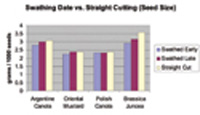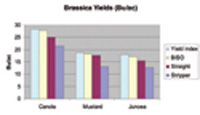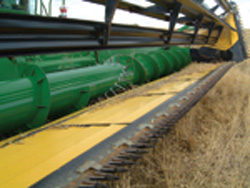
News
Harvest timing of oilseeds affects yields
Researchers then looked at seed size....
November 29, 2007 By Donna Fleury
For growers who want to straight cut oilseed crops, but are concerned about
harvest and overall yield losses, researchers at the Wheatland Conservation
Area farm may have found a solution. Since 2004, they have been comparing harvesting
options and different headers to see if straight cutting can be used successfully
for oilseeds.
The first project, which began in 2004, looked at the agronomic timing of harvest
in combination with common mechanical harvesting techniques. The oilseed crops
included Argentine and Polish canola, Brassica juncea and Oriental mustard.
Three harvest timings were compared to determine which operation would produce
the highest yield and highest seed quality, including swathing early (20 to
30 percent colour change), swathing later (60 to 70 percent colour change) and
straight cutting (100 percent colour change and dry crop).
| Figure 1. Seed size in oilseed crops at Swift Current, 2005. |
 |
"The initial results showed overall harvest losses were lowest when swathed
early and highest when straight cutting, particularly with the Argentine and
Polish canola," explains Bryan Nybo, farm manager. "However, in some
cases the losses were relatively low and didn't translate into significant yield
reductions."
Researchers then looked at seed size, which turned out to have a greater impact
on yield than harvesting technique. "We found that seed size was consistently
greater with straight cutting, while early swathing had consistently lower seed
weights," says Nybo. "When you swath early, the seeds tended to shrivel
up quite a bit more, and the seed size dropped more."
The seed size at late swathing and straight cutting were similar, although
in some cases straight cutting was the best overall. In Argentine canola and
Oriental mustard, the straight cut harvest losses were somewhat higher and outweighed
the positive effects of seed size. However, there was no significant difference
in either Polish canola or juncea when straight cut or swathed late, making
straight cutting these crops a viable option. With this information, researchers
decided to take another look at options for successfully straight cutting Argentine
and Polish canola without suffering harvest losses.
In 2005, a second study was initiated comparing three different straight cut
header options to determine losses and yield. The three headers in the study
included a rigid straight cut header, a stripper header and a BISO header extension.
The BISO header extension was provided by Robert Breckner of Grandview, Manitoba,
who brought the header in from Austria a few years ago. Researchers again compared
harvest losses and yields using the different headers in Brassica juncea, Oriental
mustard, Polish and Argentine canolas.
| Figure 2. Header type and yields in oilseeds at Swift Current, 2005. |
 |
Stripper headers, which have been around for a few years, use a series of fingers
mounted on a rotating octagonal drum to strip off the heads or pods, leaving
much of the remaining plant material standing. Header extensions, a fairly new
option, move the cutter bar forward about 18 inches on a stepped platform to
reduce cutter bar losses. The stepped platform between the old and new cutter
bar capture most of the losses, rather than letting them fall to the ground.
"We were very pleased with the straight cutting results in 2005, which
showed higher yields, including Argentine canola where losses were reduced to
the point that the results were as good as late swathing," says Nybo. Header
losses for all crops were lowest with the BISO header extension and highest
with the stripper header. The rigid straight cut header had higher losses than
the BISO header extension, but not near as high as the stripper header. The
differences were most evident in the Argentine canola, followed by juncea, then
Oriental mustard. Nybo adds, "We found the stripper header to be a premier
header for cereals and pulses, but this was not the case for oilseeds.
"We were excited about the results with the header extension and have
repeated this trial again in 2006," says Nybo. The stripper header was
replaced with a draper header for the new trial, comparing it to the rigid straight
cut header and BISO header extension. "We're trying a regular draper header
and moving the reel forward similar to the BISO extension, so when it impacts
the crop, it will fall on the draper rather than the ground in front of the
cutter bar." Nybo notes that the header extension works well with canola
because it is a bushier plant, and the reel can grab on to it and feed it into
the header extension properly. He is not sure it will work with cereals as successfully.
 |
| The BISO straight cut header features a forward mounted cutter bar and a stepped platform. |
"We're still waiting for the results of the 2006 harvest, and then we
can make better recommendations about straight cutting canola, mustard and juncea
crops," explains Nybo. "But early indications are that using a header
extension can provide growers with the option of straight cutting Argentine
canola, and the other oilseed crops with reduced harvest losses and improved
yields. We're also interested to see if there are any differences between the
draper and the BISO header extension, once the data is analyzed."
Nybo cautions that harvesting oilseeds always brings risks with it. Although
the research to-date shows better results with swathing later or straight cutting,
Nybo points out there is the risk of shattering losses due to wind. "So
far with our research, we haven't experienced much wind at harvest, so we haven't
had to deal with those losses," says Nybo. "However, if there is wind,
there isn't much you can do about shattering losses, both with a standing crop
or if a crop is laying in a swath."
The research to-date indicates that the two best options for reducing harvest
losses and improving yields for Argentine canola, as well as Polish canola,
Oriental mustard and Brassica juncea, are straight cutting at maturity using
a header extension or swathing late at 50 to 60 percent colour change. "Although
the seed losses on the ground may be higher with later swathing, the increased
seed size makes up for the losses," says Nybo. Researchers and the project
sponsor, Saskatchewan Canola Growers Association, will have the final project
results available in early 2007.